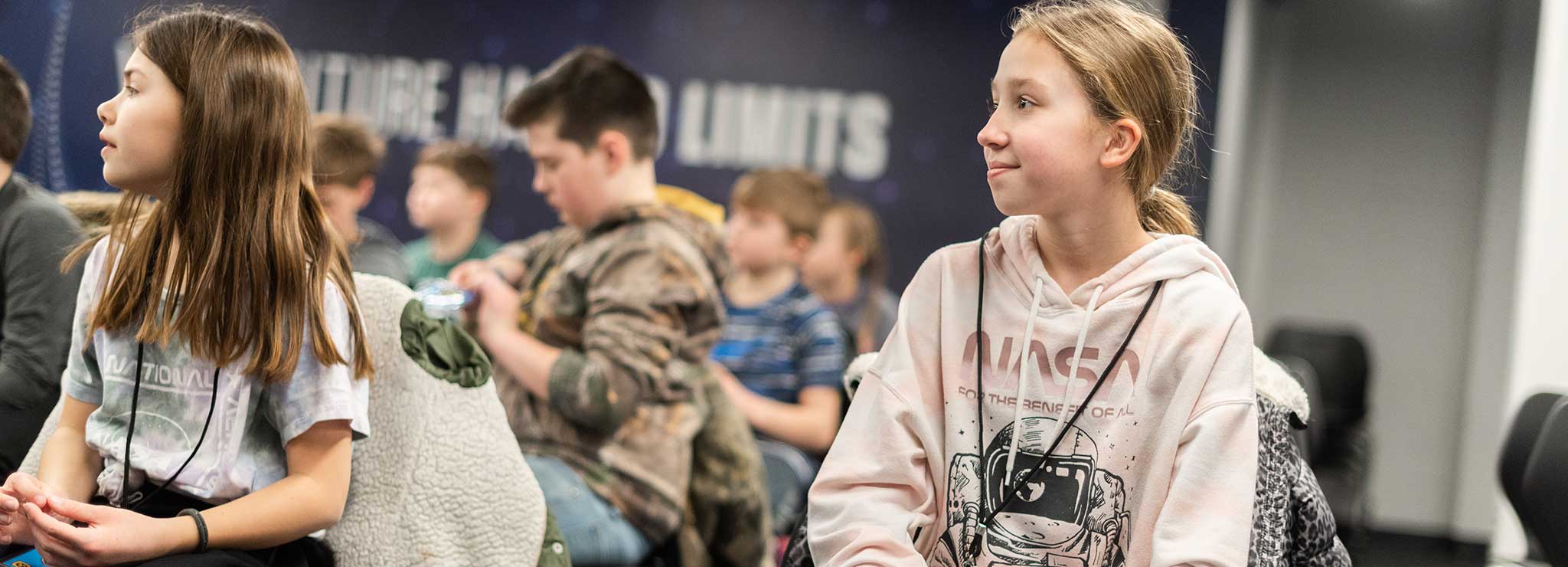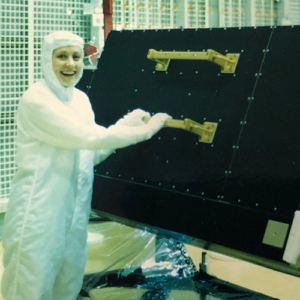Blogs | 2.22.2024
Fostering Student Identity In STEM

STEM education is about curiosity, discovery, and determination. It’s about fostering skills critical to success in the workplace (collaboration, teamwork, communication, and problem-solving) and embracing the idea of lifelong learning. STEM education opens students’ eyes to a world full of opportunities waiting to be discovered.
But how do we inspire and engage students of all backgrounds in STEM? We do so by
- tapping into their basic instinct for adventure, exploration, and futurist views;
- exposing them to STEM topics, pathways, and careers early on; and
- providing them with opportunities to develop a sense of belonging in STEM.
Like Challenger Center, NASA is implementing many incredible initiatives to engage students and educators in STEM to build a more diverse workforce. Through my previous work at NASA, I’ve had the privilege of knowing and working with Kris Brown, NASA’s Deputy Associate Administrator for STEM Engagement, for many years. An engineer by trade, Kris now provides strategic direction and executive oversight of NASA’s Office of STEM Engagement, which creates unique learning opportunities for students, as well as support for educators and educational institutions.
We recently had an opportunity to discuss her perspective on the importance of diversity and student identity in STEM . . .
Meet Kris Brown, Deputy Associate Administrator for STEM Engagement at NASA
 You and I have talked about our paths to STEM many times before. I always find it interesting exactly how much we have in common, like how we grew up. Your story is so compelling. Could you share what inspired you to pursue engineering?
You and I have talked about our paths to STEM many times before. I always find it interesting exactly how much we have in common, like how we grew up. Your story is so compelling. Could you share what inspired you to pursue engineering?
 My path to engineering was not a straight one, but my journey in STEM began early on. I grew up in a small rural factory town in central Pennsylvania. I was the first person in my family to attend college; so, I’ve learned firsthand the power of education in creating possibilities and shaping futures.
My path to engineering was not a straight one, but my journey in STEM began early on. I grew up in a small rural factory town in central Pennsylvania. I was the first person in my family to attend college; so, I’ve learned firsthand the power of education in creating possibilities and shaping futures.
Starting in early childhood and then over time, I developed a keen interest in building things and a love for drawing and design. In school, I had a strong affinity for math and science. Through the intersection of my interests, I decided I wanted to be an architect, and entered Virginia Tech School of Architecture as a freshman. While I loved the program, which was (at the time) art- and design-based, I found myself drawn to engineering. I transferred during my second year and graduated with an engineering degree.
 We each bring our own backgrounds, experiences, interests, skills, and dreams to our careers. What specifically about engineering do you believe it made such a great fit for you?
We each bring our own backgrounds, experiences, interests, skills, and dreams to our careers. What specifically about engineering do you believe it made such a great fit for you?
 What drew me to engineering was the desire to be a designer grounded in an understanding of the mechanics and function of how things work. Engineering was a great fit for the way I think and look at things. What I discovered in my academic work, and then early in my career, was how the intersection of my interests was well-aligned with the needs of the work in engineering that I was engaged in.
What drew me to engineering was the desire to be a designer grounded in an understanding of the mechanics and function of how things work. Engineering was a great fit for the way I think and look at things. What I discovered in my academic work, and then early in my career, was how the intersection of my interests was well-aligned with the needs of the work in engineering that I was engaged in.
 Early in my career, I engaged in the analysis, design, building, and testing of flight hardware. I spent many hours on the floor of our integration and testing facility at NASA Goddard in a bunny suit (the protective clothing to prevent contamination of spaceflight hardware)! This work offered me unique opportunities to learn by doing, working hand-in-hand with my colleagues (engineers, designers, and technicians).
Early in my career, I engaged in the analysis, design, building, and testing of flight hardware. I spent many hours on the floor of our integration and testing facility at NASA Goddard in a bunny suit (the protective clothing to prevent contamination of spaceflight hardware)! This work offered me unique opportunities to learn by doing, working hand-in-hand with my colleagues (engineers, designers, and technicians).
What I found as notable distinguishing factors for me as I progressed through my career, were what I viewed as my differences from colleagues, and how those differences helped enable me to provide contributions and value. What felt like challenges for me early on ended up being enablers. For example, being the only woman engineer (most of the time) felt like an immense challenge, but provided me the chance to learn a lot: How to demonstrate competence, develop meaningful and constructive relationships with team members, strive to be a valued contributor and member of the team, and build confidence. My creative yearning and architect/builder mindset helped me think outside of the box and inspire others to envision and create new approaches and innovation in our work.
Diversifying the STEM Workforce
 We have both been in the space community for more than four decades, and both have worked at NASA for much of that time. We have seen lots of positive change, while other changes not progressing enough. What is your experience and perspective on the shift in diversity in STEM over your career?
We have both been in the space community for more than four decades, and both have worked at NASA for much of that time. We have seen lots of positive change, while other changes not progressing enough. What is your experience and perspective on the shift in diversity in STEM over your career?
 Early in my engineering career, women represented less than 9% of the U.S. engineering workforce. I was typically—and literally—the only woman in the room. Unfortunately, today we aren’t doing much better, with women making up about 15% of the engineering workforce, according to 2019 Pew Research data. Beyond gender, Blacks, Hispanics, and American Indians/Alaska Natives also continue to be underrepresented in STEM.
Early in my engineering career, women represented less than 9% of the U.S. engineering workforce. I was typically—and literally—the only woman in the room. Unfortunately, today we aren’t doing much better, with women making up about 15% of the engineering workforce, according to 2019 Pew Research data. Beyond gender, Blacks, Hispanics, and American Indians/Alaska Natives also continue to be underrepresented in STEM.
 We can certainly do better in diversifying STEM—through education and in the workforce. Based on your experience and from your perspective, why is diversity in the STEM workforce so important?
We can certainly do better in diversifying STEM—through education and in the workforce. Based on your experience and from your perspective, why is diversity in the STEM workforce so important?
 We need to shift the demographics of the STEM workforce to better reflect the population of our nation that we serve. And we clearly need to do better in building and sustaining a healthy and diverse pipeline of future STEM workers.
We need to shift the demographics of the STEM workforce to better reflect the population of our nation that we serve. And we clearly need to do better in building and sustaining a healthy and diverse pipeline of future STEM workers.
Doing so is vital for us to meet the demands and challenges we are experiencing globally, such as issues regarding public health and climate change, and to achieve needed technological advances in multiple sectors including the aerospace industry. STEM is at the center of driving innovation, sustaining our economy, enabling discoveries, and making profound societal impact. The future of our country and our planet depends on increasing our workforce.
Fostering STEM Identity in Today’s Students
 I love your answer—you reveal your humanistic heart that is at the core of many of us working in STEM fields. We truly care about people and the future. So let’s take it a step further: What is the critical step to helping students on this path to a fulfilling and impactful career?
I love your answer—you reveal your humanistic heart that is at the core of many of us working in STEM fields. We truly care about people and the future. So let’s take it a step further: What is the critical step to helping students on this path to a fulfilling and impactful career?
 Building STEM identity is critically important to attracting and sustaining students in STEM pathways. The power of experiential learning and exposure to different people who work in STEM is compelling when building career awareness and STEM identity.
Building STEM identity is critically important to attracting and sustaining students in STEM pathways. The power of experiential learning and exposure to different people who work in STEM is compelling when building career awareness and STEM identity.
Those of us in the STEM education ecosystem know the need to attract kids to STEM early (before they transition from middle school), to keep them on track and be able to help sustain them on STEM pathways. Helping girls and boys envision themselves in STEM through the lens of someone who looks like them is vital to successfully attracting them to STEM, especially for those students from underrepresented groups.
 Let’s talk about an organization we both love—NASA! How has NASA connected students to STEM careers? And how can we continue to convey the power of STEM to them?
Let’s talk about an organization we both love—NASA! How has NASA connected students to STEM careers? And how can we continue to convey the power of STEM to them?
 At NASA, we are committed to putting our ‘STEM superstars’ in the spotlight and connecting them with students in meaningful ways. The impact of building those connections is palpable. I experience it each time I’m involved in our work with students—it’s what I call ‘goosebump moments’. Having kids engage with people they can readily connect to—and experience them doing really cool work while achieving amazing things—will foster their STEM identity.
At NASA, we are committed to putting our ‘STEM superstars’ in the spotlight and connecting them with students in meaningful ways. The impact of building those connections is palpable. I experience it each time I’m involved in our work with students—it’s what I call ‘goosebump moments’. Having kids engage with people they can readily connect to—and experience them doing really cool work while achieving amazing things—will foster their STEM identity.
Beyond these career connections, there is a strong need for us to get better at conveying the power of STEM and delivering what I’d frame as key messages about what we do and experience in STEM. For many young students, there is little connection between their schoolwork and academic experiences to STEM professions and applications in their day-to-day lives. And for older students, we can improve how we talk about STEM careers in terms of what we do, how we do it, and why. We need to build bridges to STEM, and that begins with us.
When I’m with students, I focus on key elements of STEM careers. As an engineer, I convey how engineers are really creative people who love their work. I also describe how fun, fulfilling, and energizing our work is, and that it is a ‘team sport’ where we get to work with lots of great people. Finally, and most significantly, I highlight that, as STEM people, we create new things and enable new discoveries, that our work really matters, and that we make a difference in the world.
Communicating the value of the work we do and the ability to contribute to society resonates with young people . . . especially in helping to attract girls to STEM.
Looking to the Future
A big thank you to Kris for taking the time for this interview and helping illuminate a clear path forward in STEM education.
To inspire the next generation of STEM leaders, we must show students from all backgrounds that science, technology, engineering, and math aren’t just subjects in their textbooks, but rather critical topics that impact our society in the real world. By showing them professionals who look like them, sound like them, and come from their same communities, we can show students how they fit into the puzzle. Not only can we give students a sense of belonging in STEM, but we can give them the ability to imagine their futures in STEM careers. Which, in turn, will contribute to successfully improving our STEM pipeline.
Stay tuned to the Challenger Center Blog! This was just the first in a three-part series. Next month, Kris and I will continue this discussion, focusing on some challenges and solutions regarding the STEM pipeline.
